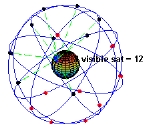
, a satellite is an object which has been placed into orbit
by human endeavour. Such objects are sometimes called artificial satellites to distinguish them from natural satellite
s such as the Moon
.
The world's first artificial satellite, the Sputnik 1
, was launched by the Soviet Union in 1957. Since then, thousands of satellites have been launched into orbit around the Earth
; also some satellites, notably space station
s, have been launched in parts and assembled in orbit.
1957 Project Vanguard: A launchpad explosion of Vanguard TV3 thwarts the first United States attempt to launch a satellite into Earth orbit.
1958 Explorer program: ''Explorer 1'' – The first successful launch of an American satellite into orbit.
1958 The United States launches the Vanguard 1 satellite.
1958 The Soviet satellite Sputnik 2 falls from orbit after a mission duration of 162 days.
1962 First transatlantic satellite television transmission.
1962 ''Alouette 1,'' the first Canadian satellite, is launched.
1962 NASA "Relay 1" launch, first active repeater communications satellite in orbit.
1965 Launch of Early Bird, the first communications satellite to be placed in geosynchronous orbit.
1965 In the Hammaguir launch facility in the Sahara Desert, France launches a Diamant-A rocket with its first satellite, ''Asterix-1'' on board, becoming the third country to enter outer space.
1970 The first Chinese satellite, Dong Fang Hong I, is launched.

